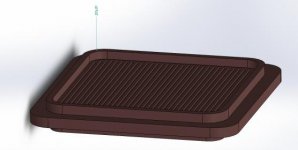Hey guys, I've worked around machines in the model, pattern, and mold industries for almost a decade. That said, what I'm doing on my own as a gov't project has me a bit uneasy as far as how to do what I need to do.
At the bottom of a roughly 1.5" square flat pad, I need to cut a number of slots that are about .018" wide and as deep as I can realistically make them. (.020" at the least, would like .030"). I'm out of my wheelhouse here. I ordered a couple of different half mil carbide cutters... And plan on running them at just a couple IPM, so slow slow slow. Lead ins will be shallow and stepdowns miniscule at maybe a thou. I'm limited to 6500 rpm. 3 axis vmcs. They're accurate as I take good care of them.
Is there anything I can do to be careful here? Any tips or tricks? Am I looking at this the wrong way? Make it not take a lifetime to cut? Being a rotational mold guy, my daily job is making big things, and any small details just have to look good, not be good. I need to cut at least 40 of these slots per piece, and at this rate it'll take a whole night, assuming the cutter survives, to cut, and I essentially relegate all my free spindle time to one toolpath.
I've heard some other methods of doing this thrown around, but I can't for the life of me remember the names. I eventually want to take this into production once my prototypes mature, and I don't want to shop it out. Any and all help would be super appreciated.
Thanks!
At the bottom of a roughly 1.5" square flat pad, I need to cut a number of slots that are about .018" wide and as deep as I can realistically make them. (.020" at the least, would like .030"). I'm out of my wheelhouse here. I ordered a couple of different half mil carbide cutters... And plan on running them at just a couple IPM, so slow slow slow. Lead ins will be shallow and stepdowns miniscule at maybe a thou. I'm limited to 6500 rpm. 3 axis vmcs. They're accurate as I take good care of them.
Is there anything I can do to be careful here? Any tips or tricks? Am I looking at this the wrong way? Make it not take a lifetime to cut? Being a rotational mold guy, my daily job is making big things, and any small details just have to look good, not be good. I need to cut at least 40 of these slots per piece, and at this rate it'll take a whole night, assuming the cutter survives, to cut, and I essentially relegate all my free spindle time to one toolpath.
I've heard some other methods of doing this thrown around, but I can't for the life of me remember the names. I eventually want to take this into production once my prototypes mature, and I don't want to shop it out. Any and all help would be super appreciated.
Thanks!




